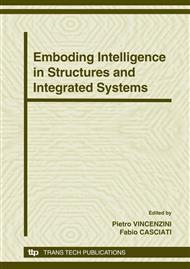[1]
Lim, S.C., Tomizuka, M., Shoureshi, R.A. (2003), ""Strategic Research for Sensors and Smart Structures Technology," Editors Wu and Abe, Swets and Zeitlinger, 2003 Issue, pp.113-177.
Google Scholar
[2]
Liu, S.C., et al. (1993), "Civil Infrastructure Systems Research: Strategic Issues," National Science Foundation.
Google Scholar
[3]
Small, E., Cooper J. (1998), "Condition of the Nation's Highway and Bridges, A Look at the Past, Present, and Future," TR News, January/February Issue.
Google Scholar
[4]
Shoureshi, R.A. (2004), "Sensor Informatics and Advanced Control for Civil Structures," Keynote Lecture, 3rd International Conference on Earthquake Engineering, Naning, China, October 2004.
Google Scholar
[5]
Straser, E.G., Kiremidjian, A.S. (1996), "Monitoring and Evaluating Civil Structures Using Measured Vibration," Proceedings of 14th International Modal Analysis Conference, 84.
Google Scholar
[6]
Mal, A.K., Ricci, F., Gibson, S. (2004), "Damage Detection in Structures from Vibration and Wave Propagation Data," Proceedings of the 2004 SPIE NDE Conference, March, Session 6 #5047-25.
Google Scholar
[7]
Casciati, F., Faravelli, L. (2004), "Wireless Links between Sensor-Device Control Stations in Long Span Bridges", Proceedings of the 2004 SPIE-Smart Structure Conference, March, Session 1 #50507-01.
DOI: 10.1117/12.482387
Google Scholar
[8]
Kim, G. Kwon, I., Choi, M. (2004), "Structural Health Monitoring System Using Internet and Database Technologies", Proceedings of the 2004 SPIE-Smart Structures Conference, March Session 1 #5057-03.
Google Scholar
[9]
Kurata, N., Spencer, B.F. (2004), "Risk Monitoring by Ubiquitous Sensor Network for Hazard Mitigation", Proceedings of Smart Structures Technologies and Earthquake Engineering, 145, SE-2004, Osaka, Japan.
Google Scholar
[10]
Ou, J., Li, H. (2004), "Recent Advances of Structural Health Monitoring in Mainland China", Proceedings of ANCER Annual Meeting, Hawaii, July.
Google Scholar
[11]
Shinozuka, M., Fend, M.Q., Chou, P. (2004), "MEMS-Based Wireless Real-time Health Monitoring of Bridges," Proceedings of the 3rd International Conference on Earthquake Engineering, Nanjing, China, October.
Google Scholar
[12]
Lynch, Jerome P. (2004), "Design of a Wireless Active Sensing Unit for Structural Health Monitoring," Proceedings of SPIE - The International Society for Optical Engineering, v 5394, Health Monitoring and Smart Nondestructive Evaluation of Structural and Biological Systems III, 157.
DOI: 10.1117/12.545572
Google Scholar
[13]
Han, L. (2004), "Centralized Remote Structural Monitoring and Management of Real-Time Data," Proceedings of SPIE - The International Society for Optical Engineering, v 5393, Nondestructive Evaluation and Health Monitoring of Aerospace Materials and Composites III, 55.
DOI: 10.1117/12.548115
Google Scholar
[14]
Gheorghiu, Catalin 2004), "Fatigue and Post-Fatigue Performance of Fabry-Perot FOS Installed on CFRP-Strengthened RC-Beams," Proceedings of SPIE - The International Society for Optical Engineering, v 5393, Nondestructive Evaluation and Health Monitoring of Aerospace Materials and Composites III, 76.
DOI: 10.1117/12.548112
Google Scholar
[15]
Rivera, E. (2004), "Civionics Specifications for Fiber Optic Sensors for Structural Health Monitoring," Proceedings of SPIE - The International Society for Optical Engineering, v5393, Nondestructive Evaluation and Health Monitoring of Aerospace Materials and Composites III, 161.
DOI: 10.1117/12.548117
Google Scholar
[16]
Iwasaki, Atsushi (20040, "Damage Diagnosis for SHM of Existing Civil Structure with Statistical Diagnostic Method", Proceedings of SPIE: Health Monitoring and Smart Nondestructive Evaluation of Structural and Biological Systems III, 411.
DOI: 10.1117/12.539467
Google Scholar
[17]
Knoblauch M, Noll GA, Müller T, Prüfer D, Schneider-Hüther I, Scharner D, van Bel AJE, and Peters W. (2003), "ATP-Independent Contractile Proteins From Plants", Nature Materials 2, 600.
DOI: 10.1038/nmat960
Google Scholar
[18]
W. Pickard, M. Knoblauch, W. Peters & A. Q. Shen (2005), "Prospective Energy Densities in the Forisome: A New Smart Material", Materials Science and Engineering: C Biomimetic and Supramolecular Systems.
DOI: 10.1016/j.msec.2005.06.055
Google Scholar
[19]
Q. Shen, B. Hamlington, W. Pickard, M. Knoblauch & W. Peters (2005), "Forisome Based Biomimetic Smart Materials," Smart Materials and Structures, 2005.
DOI: 10.1117/12.606602
Google Scholar
[20]
Bent, A.A., Hagood, N. and J. Rodgers (1995), "Anisotropic Actuation with Piezoelectric Fiber Co-posits," Journal of Intelligent Materials in Systems Structures, Nov. 6, 338-349.
DOI: 10.1177/1045389x9500600305
Google Scholar
[21]
Widmairer, E., Raff, H., Strang, K. (2004). Human Physiology: The Mechanisms of Body Function (9 th Ed.) McGraw Hill.
Google Scholar
[22]
Shoureshi, R.A. and Shin, Amy Q. (2007), "Design of a Biomimetic-Based Monitoring and Diagnostic System for Civil Structures," Int. J. Nanotech, 4(3).
Google Scholar
[23]
Henderson, I.R. (2004) Piezoelectric Ceramics: Principles and Applications, APC International, Mackeyville, PA
Google Scholar
[24]
"New Ceramic Fiber Technology Unlocks the Power of Piezo," Advanced Ceramics. Version 1, revision 6-final, Dec. 5, 2005.
Google Scholar


